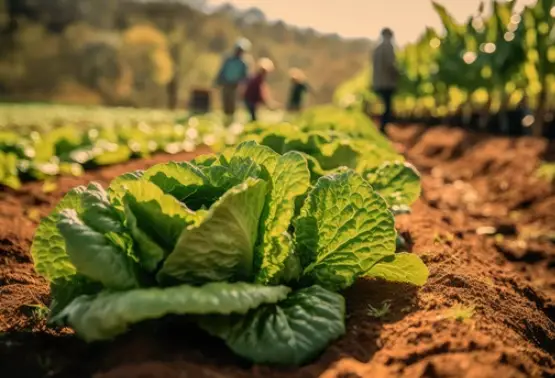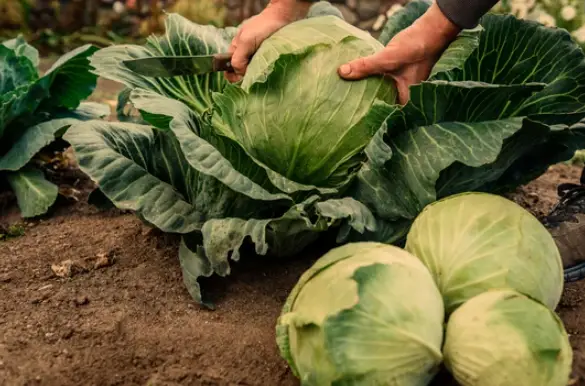A common vegetable that may be cultivated in many climates is cabbage. It is a robust crop that thrives in cold climates, making it a fantastic choice for fall and winter gardens.
The secret to obtaining the finest flavor and texture out of your crop is knowing when to harvest the cabbage. How to determine when cabbage is ready to be harvested will be covered in this post.
The size of the head should be taken into account as the first factor in deciding when to harvest your cabbage.
The heads of the cabbage should be compact and firm, with no obvious flaws or gaps.
Depending on the type of cabbage you are growing, the size of the head will vary, but the majority will measure between 6 and 10 inches in diameter.
It is crucial to remember that cabbage heads cannot grow any further once they reach maturity, making it crucial to harvest them at the appropriate time.
The color of the leaves is another aspect to take into account when harvesting cabbage.
The color of the cabbage leaves should be a bright green, without any yellowing or browning.
The cabbage may be overripe and past its peak if the leaves are beginning to yellow. In addition, wilting or damaged leaves may indicate that the cabbage is not yet ready for harvest.
You can make sure your cabbage is harvested at the ideal time for the best flavor and texture by keeping an eye on the size of the head and the color of the leaves.

Cabbage Growth Cycle
Cabbage is a cool-season crop that requires a long growing season to reach maturity. Understanding the growth cycle of cabbage is essential to know when to plant, care for, and harvest the crop.
Planting
Cabbage is a biennial plant that grows best in cool weather. The ideal temperature for planting is between 45°F and 75°F. Cabbage can be planted in the spring or fall, depending on the variety and location. Early varieties are planted in the spring and mature in 60-70 days. Late varieties are planted in the fall and mature in 80-180 days.
Germination
Cabbage seeds take 7-14 days to germinate. The soil should be kept moist during germination, and the temperature should be between 60°F and 70°F. Once the seedlings have emerged, they should be thinned to 12-18 inches apart.
Vegetative Growth
During the vegetative growth stage, cabbage plants develop leaves, stems, and roots. The plant requires regular watering and fertilization to grow healthy and strong. The ideal temperature for vegetative growth is between 60°F and 70°F.
Head Formation
As the cabbage plant matures, it begins to form a head. The head formation stage lasts 2-4 weeks, depending on the variety. Late varieties take longer to form a head than early varieties.
Harvesting
Cabbage is ready to harvest when the head is firm and solid. The ideal time to harvest is in the morning when the head is cool and crisp. Late varieties can be left in the ground until after the first frost. Cabbage should be harvested before the ground freezes.
In conclusion, understanding the growth cycle of cabbage is crucial to growing a healthy and productive crop. Proper planting, care, and harvest are essential for a successful cabbage harvest.
Recognizing Mature Cabbage

How to Determine When Cabbage is Ready to Harvest
Cabbage is a cool-season crop that grows best in spring and fall. Harvesting cabbage at the right time is essential for the best flavor and texture. Here are some tips on how to recognize mature cabbage:
Head Size
The size of the cabbage head is one of the most important indicators of maturity. Most varieties of cabbage take around 70-100 days to reach maturity, depending on the variety and growing conditions. A mature cabbage head should be firm, dense, and heavy. It should also be of a size appropriate for the variety you are growing.
Head Firmness
The firmness of the cabbage head is another important factor to consider when determining if it is ready to harvest. A mature cabbage head should be firm to the touch and not feel spongy or soft. You can check the firmness of the cabbage by gently squeezing it with your hand. If it feels hard and solid, then it is likely ready to harvest.
Leaf Color
The color of the cabbage leaves can also be an indicator of maturity. As the cabbage head matures, the outer leaves will begin to turn yellow or brown and may even start to curl up. This is a natural process and is a sign that the cabbage is ready to be harvested. However, if the leaves are wilted or have spots, this could be a sign of disease or insect damage and the cabbage should not be harvested.
Days to Maturity
Knowing the days to maturity for your specific cabbage variety can help you determine when it is ready to harvest. Check the seed packet or plant label for information on the days to maturity. Once the estimated time has passed, start checking the cabbage regularly for maturity.
In summary, recognizing mature cabbage involves checking the head size, firmness, leaf color, and days to maturity. By following these tips, you can harvest your cabbage at the peak of its flavor and texture.
Checking the Firmness

One of the most important indicators of cabbage readiness is its firmness. A cabbage that is ready to harvest should be firm to the touch. The leaves should be tightly packed together, and there should be no signs of wilting or softness.
To check the firmness of a cabbage, gently press your finger against the head. If it feels firm and solid, it is likely ready to harvest. If it feels soft or mushy, it may be overripe or damaged.
It’s important to note that the firmness of a cabbage can vary depending on the variety and growing conditions. Some varieties may naturally be softer or more prone to wilting than others. Additionally, environmental factors such as temperature and moisture levels can impact the firmness of the cabbage.
To ensure the best quality cabbage, it’s recommended to harvest when the heads are at their firmest. Waiting too long can result in a loss of flavor and texture, as well as an increased risk of pest and disease damage.
In summary, checking the firmness of the cabbage is an important step in determining when it is ready to harvest. A firm head with tightly packed leaves is a good indicator of readiness, while softness or wilting can indicate overripeness or damage.




